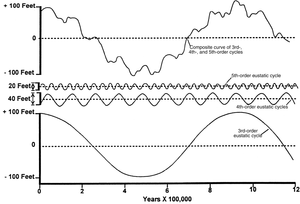Sequence stratigraphy: hierarchy of sequences
| Exploring for Oil and Gas Traps | |

| |
| Series | Treatise in Petroleum Geology |
|---|---|
| Part | Predicting the occurrence of oil and gas traps |
| Chapter | Exploring for stratigraphic traps |
| Author | John C. Dolson, Mike S. Bahorich, Rick C. Tobin, Edward A. Beaumont, Louis J. Terlikoski, Michael L. Hendricks |
| Link | Web page |
| Store | AAPG Store |
Global sea level changes (eustacy) are cyclic phenomena. Six orders of sea level cycles are recognized from stratigraphic evidence.[1] Third-, fourth-, and fifth-order sea level cycles model sequence deposition for petroleum exploration. A third-order sequence is a composite of fourth- and fifth-order sequences.
The table below shows sea level cycle frequencies, thickness ranges, and stratigraphic names for third-, fourth-, and fifth-order sequences.
| Sequence order | Cycle frequency, m.y. | Thickness, m | Stratigraphic name |
|---|---|---|---|
| Third | 0.5–5 | 100–1000 | Sequence |
| Fourth | 0.1–0.5 | 1–10 | Parasequence |
| Fifth | 0.01–0.1 | 1–10 | Parasequence |
Superimposition of cycles

Several frequencies, representing different orders of sea level cycles, are superimposed on one another to make a composite sea level cycle curve. For stratigraphic trap exploration, cycles that impact trap location are usually third-, fourth-, and fifth-order sea level cycles. Figure 1 shows how adding third-, fourth-, and fifth-order cycles together will produce a composite curve.
See also
- Sequence stratigraphy
- Third-order sequences
- Fourth- and fifth-order sequences (Parasequences)
- Traps in a framework of sequence stratigraphy
References
- ↑ 1.0 1.1 Van Wagoner, J. C., Mitchum, R. M., Campion, K. M., Rahmanian, V. D., 1990, Siliciclastic Sequence stratigraphy in Well Logs, Cores and Outcrops: Concepts for High-Resolution Correlation of Time and Facies: AAPG Methods in Exploration Series No. 7, 55 p.